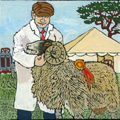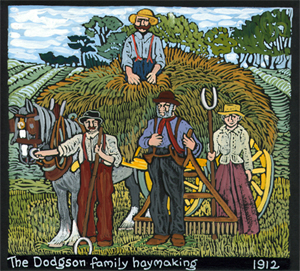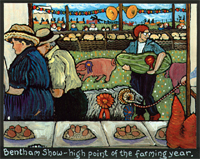|
Since the earliest times, Benthamers
have farmed. In 1086 the Domesday Book recorded 18 "geldable
carucates", meaning about 2000 acres in cultivation, and
this was profitable enough to build three parish churches. As
a writer observed in 1892, "The favoured and fertile lands
about Bentham, watered by the
pleasant Wenning, were ever since the Roman occupation the home
of an active agricultural class".Over the centuries, the
original vegetation has been gradually changed by the activities
of man and flocks. Countless generations have worked in all weathers,
draining, liming, controlling the grazing, transforming the valley.
Once it was boggy, with dense thickets of alder and willow; nowadays
it is mainly good grassland.
But the wilderness has not been eradicated, and all kinds
of wildlife and flowers still abound on the farms, moors and
woodland all around. Pest- and herbi-cides are not popular with
the thrifty farmers hereabouts.

A Champion Swaledale Tup at Bentham
Show
Making hay has always been a nerve-racking
occupation in our uncertain northern summers, so nowadays most
local farmers make and feed silage, which, unlike hay, does not
need hot sunshine to dry out the grass. The downside is the large
and unsightly quantities of black plastic and motor-tyres involved
in this process. However the Auction Mart Co. have a recycling
scheme for the plastic, and the tyres would otherwise be in a
landfill dump somewhere.
 |
 From about 1150 onwards, the great Yorkshire From about 1150 onwards, the great Yorkshire
Abbeys owned vast roaming sheepflocks, tended
in outlying areas like this by often unruly bands of young monks.
The system was impractical and unpopular. Walls began to be built,
and previously "waste" land enclosed. The wealth of
England came from wool, and the rights of sheep became paramount.
By about 1800 most of the common grazing had been privatized,
and most of the "peasants" had fled to the new industrial
towns - it was that, or starve. But around Bentham much of the
moorland remained unenclosed, and the small -scale Yeomen farmers
managed to "make a do" somehow. At the last count (1964),
294 farms and other dwellings still held and used various Commoner's
rights such as grazing, turbary, & pannage on Newby Moor.
 |
Independent farming was encouraged by
having a nearby market. Bentham's Fair and Markets Charter was
granted by King Edward I in 1306. Regular livestock auctions
have been held since 1803, when the firm of R. Turner & Son
was established. This has provided a ready outlet for locally-bred
and reared animals and made Bentham famous for its Fat Sheep.
The Foot and Mouth Disease epidemic of 2001 was an unwelcome
interruption to this vital local activity.
In the 19th. century a fashion for
breeding enormous animals swept Britain. The Craven Heifer (a
shorthorn) was a famous example. At four years old, when her
portrait was painted, she
weighed 176 stone, and was 11ft. long and 10 ft (3m) round the
middle. You can see her on the Heritage Trail map, at the top. Prizes for All Sorts at Bentham
Show Prizes for All Sorts at Bentham
Show
Before steam machinery and tractors
arrived in these parts, the great Horse and Hiring Fair held
each Midsummer brought in extra labour for haytime. In the 1850's,
for instance, 2000 itinerant workers and 300 horses would arrive
overnight to throng the street and seek employment. This no longer
happens, alas, but the annual Bentham Agricultural Show in September
still celebrates local farming skills, achievements and interests.
Until quite recently, much local food was also produced locally,
meat and dairy produce in particular. Times have changed, but
should the need arise Bentham could quickly return to self-sufficiency.
|